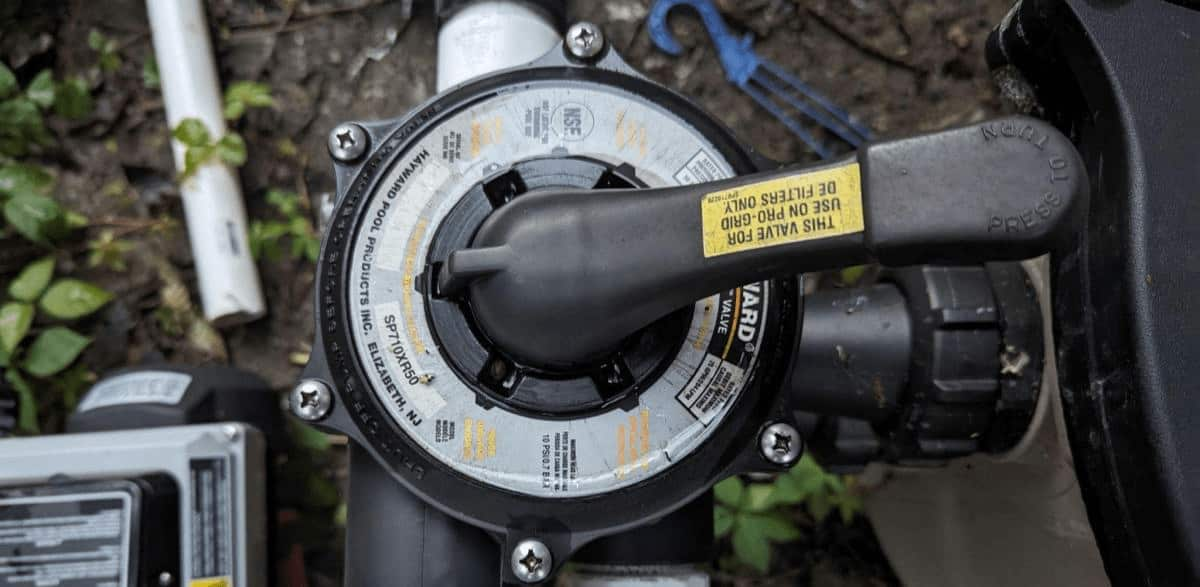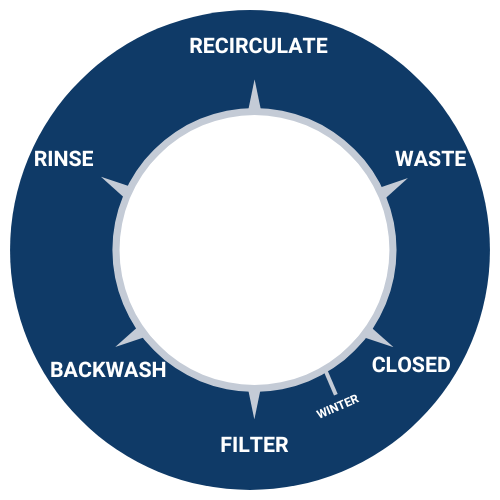The Multiport Valve and the 7 Different Positions

Pool valves are not mentioned when talking about important parts of a pool. The multiport valve in particular, can change the water flow in 7 different ways!
Depending on your type of pool filter, a multiport valve can make troubleshooting, pool closing, and general pool maintenance much easier.
Let’s go into the multiport valve and its settings.
Understanding What a Multiport Valve Does
First, understand that multiport valves are only used on sand or diatomaceous earth (DE) filters. They are not for cartridge filters.
These valves are aptly named because they allow multiple “ports,” or entry points, for pool water to enter and exit the filter.
6-position lift and turn handle for desired filter operation.
Typically located on the side or top of a filter, the multiport valve will help filter and clean water while removing contaminants we might not want to get into the pool filter.
Depending on what needs to be done, the valve will help direct the water to where it needs to be.
The Multiport Valve Positions

The multiport valve will come with a handle that allows you to easily position the valve in different settings depending on what needs to be done.
Most multiport valves will have 6 different positions or settings, with an added “winter” position that doesn’t occupy a position, but we will get into that!
FILTER
The FILTER position is the valve’s “standard” setting. It’s the position that allows water to run through the filter and will stay in this position for most of the time.
Water will flow from the suction lines to the pool pump, into the filter where it gets cleaned, and return to the pool through the return lines.
When to use FILTER: Use this position for everyday filtration when the pool is in use.
BACKWASH
The BACKWASH setting is used to clean your DE and sand filters. Rather than taking the grids out and manually cleaning them as you do with cartridge filters, backwashing allows you to flush out the grids and filtration media without the need to remove them.
This position reverses the water flow, forcing it to go backward through the filter, which cleans the grids (enters through the exit and exits through the entrance!). Instead of returning to the pool through return lines, it is directed to a waste line connected to a hose.
When to use BACKWASH: When your pressure gauge PSI reads about 25% above its normal operating pressure or dirty water is returning to the pool, it is time to backwash the filter. Most gauges have a color-coded reading to make it easier to understand when it’s time to backwash.
RINSE
After a backwash, leftover sediment and dirt can remain in the filter tank. When you turn the pump on, chances are that dirt will go directly into the pool which is not ideal!
The RINSE setting helps remove that remaining sediment in the filter. Water goes through your system like a normal FILTER setting but will go out the waste line instead of the return lines.
When to use RINSE: RINSE should only be used after a backwash. After finishing the backwash, use the RINSE setting for around 30 seconds to clean the rest of the filter.
RECIRCULATE
RECIRCULATE is a complete bypass of the pool filter. There are instances where the filter cannot be used because it leaks or is not working properly.
The RECIRCULATE position allows water to flow and circulate the pool until the filter can be fixed. Water will go through the pump, into the multiport valve, and directly back to the pool through the return lines.
When to use RECIRCULATE: When the pool filter is broken or cannot be properly used, use this setting to keep water circulating.
WASTE
There are times when all you want to do is to remove water. If a storm forced you to drain the pool, or if you have a lot of debris and dirt on the floor and don’t want to clog the filter, the WASTE setting is your friend.
This setting will send water directly from the pump into the multiport valve and out into the waste line without going into the filter.
When to use WASTE: Anything we want to remove without passing through the filter should be set to the WASTE position.
CLOSED
The CLOSED setting will most likely be the least used position and may never need to be used.
It seals up the multiport valve and will not let water enter or exit. Very rarely does this need to happen, however.
When to use CLOSED: While you may never use it, the CLOSED position can benefit owners with equipment below the water level. It can act as a check valve so water does not flow back into the filter when the pump is turned off.
WINTER
If your multiport valve happens to have the WINTER setting, you’ll notice that it isn’t a position on the valve. This is done on purpose.
This position will leave the ports in the valve slightly open, allowing space for trapped water to expand into ice during colder months. If water is trapped inside a closed valve, there is a higher chance for it to crack
When to use WINTER: Use this setting during the off-season, colder months to ensure water can escape the valve. If your filter does not have a WINTER setting, set the valve between 2 positions so it isn’t locked to a setting. This will have the same effect.
The Positions Which Will Lose Water
Multiple positions on the multiport valve will lose pool water. Take this into consideration before using them and make sure you can replace water if necessary.
These positions are BACKWASH, RINSE, and WASTE.
One Valve to Rule Them All
The multiport valve is a very valuable tool to help assist in many different scenarios.
It’s important to remember always to have the pump turned off when switching filter positions. Turning it while the system is running can damage the valve and can even potentially cause it to blow.
Again, keep the pump off when switching positions and there will be no problems!

